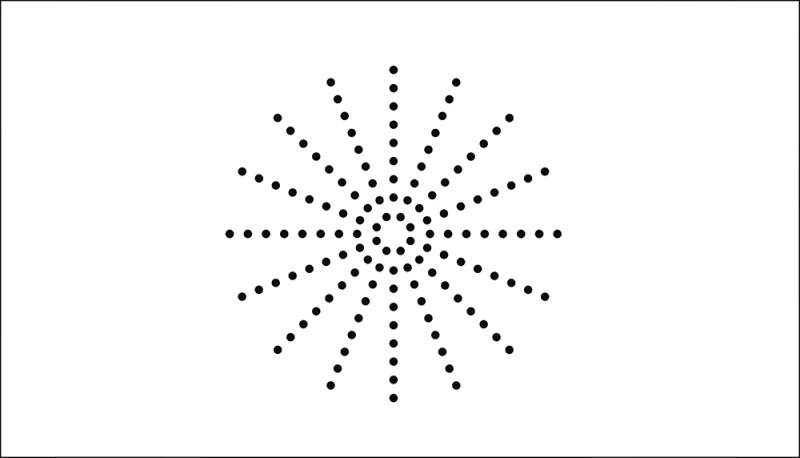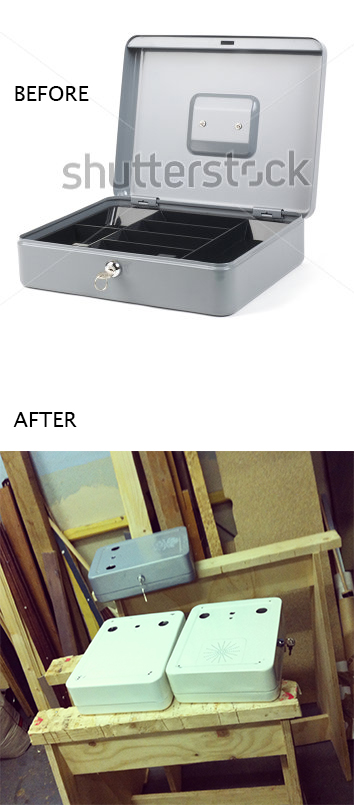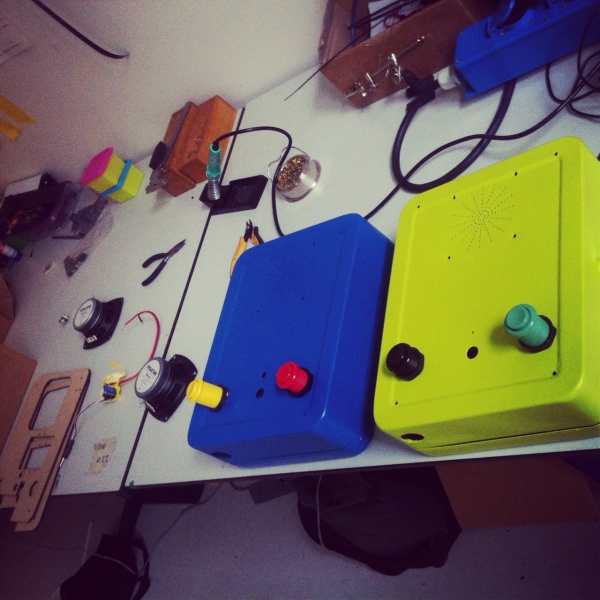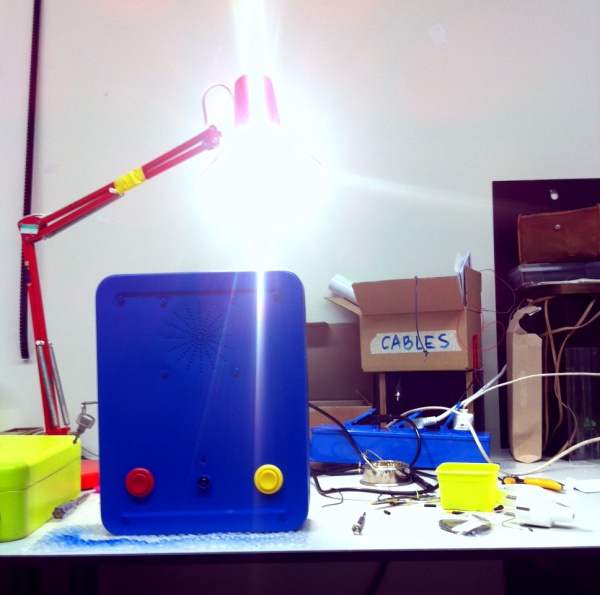User:Yoana Buzova/ ths
INTRODUCTION
The situations I find myself in, become an urgency for my work and research. How to understand an environment as a stranger to it. I find being a stranger both here and in my country. Detached from there even before leaving. And unattached, floating here, surrounded by foreign voices. At the beginning is a bliss not to understand, to have no relationship with meaning. Then after some time the pleasure of being isolated from the production of meaning of the voice , turns into a delicate, permanent discomfort. My curiosity asks if it will be possible to translate this feeling and bring it back to the streets. Maybe this time as something curious and pleasant. This question becomes the reason for my project and research in the past and following months. For the last months I have been working on initiating a network of voice mailboxes in public space. Boxes mailboxes that allow members of the public to record and distribute audio messages in public space. A network of boxes, that exist in different countries in urban public spaces. They are all connected, so that the last recorded message on any of the boxes will be played back on all of the boxes in the network. As soon as a new recording is made, it becomes the one played on all devices. Thus the boxes facilitate a non-instant, slow dialogue between strangers, travelling an unplanned journey trough cityscapes. An exploration of isolation and connectivity in public spaces. I have initiated the creation of a little fragment of contact, a way of briefly connecting in a typically disparate and isolating city. A monent of communication and miscommunication at the same time. Finding myself in constant flux, transition, on the border of feeling comfortable and anxious, at home but still foreign, I see why I am fascinated by the object voice. Mladen Dolar identifies the voice as a “zone of overlapping, the crossing, the ”extimate. It is somewhere between interiority and exteriority. Voices contain a certain public moment in time. Voices enact the social space that is embedded in the every day. The voice is an intersection between personal and social.
CH1
watching and listening to the streets
The following chapter will elaborate on my methodology and its development throughout the course and support it with case studies of previous projects, as well as my graduation research and project.
In my work, I develop research methods and experiments with various media. Currently I focus on building tangible works and experimenting with DIY (do-it-yourself) strategies both physically and virtually. My interest is in using low-tech, simple, accessible methods in unexpected combinations. I examine processes of encoding, signification and communication to bring personal moments.
In my previous projects in the context of photography as my main tool, I gained considerable observer skills/ silent/ looking/ listening/ taking with me. In my images, I have been dealing with subjects somehow similar to my current interests, mostly observation and isolation of neglected objects and situations. One of my projects is a series of portrait photoshoots, from which I work the trash and use the unwanted moments (images desired to be deleted). Amplifying them, manipulating them and asking of their meaning and value. 'The Blind Love' is a print project, a book with fragments of Boris Vian's story with the same name. Illustrated with photographs, where I isolate existing trivial objects, moments and details and put them in the context of the text to give them a new meaning. Recently I seem to be shifting to using photography as a tool for documentation, going back to basic purposes. Using it as initial input, a sketch to use later and build on. Is no longer a final presentation medium. I use it to examine and explore it later as source of information.
I have a fascination for looking at short-lived, transient situations and objects, I see them and want to collect them, transform them and bring them back in another form. In my work I focus on simplicity and invisible information layers in our environment. I like finding minimal situations in uncommon, contrast places. In most of my works I look for tangibility and materiality, low-tech, diy and found object/moment strategies. I find and collect self-organized structures that i could translate, disassemble, modify so that the emerging form is my work. This is the role of an observer that choses, collects, transforms and makes something new. My methodology is to immerse myself into situations and find in them other ones. I immerse myself trough looking and listening, with or without passing judgement on the collected impressions. I like to take a break and be slow, catch my breath and look around. In unconscious structures i find unpredictability, unrepeatability, algorithm, randomness, endless combinations and recombinations. I discover these methods in the projects that started in the first trimester of the course. In message delivery, work from first trimester with Mathaijs van Oosterhoudt, the focus is on self-driven , chain reaction urban encounters. A very primitive, manual adventure of hand-written notes that travel trough the city from person to person and we (the project initiators) serve only as couriers to facilitate, observe and document the randomness of manual interactions. In my video feedback experiments I also take the position of a viewer rather than a director of the work, recording a generative, self-generated visual result.
After working on smaller projects, and experimenting with different approaches, my interest toward urban spaces stood out and pointed my next work. The case study is the project 'Street Compositions'. The project has two parts and they could be seen as independent works but also as elements of one work. First part of the work is a custom made music box set. It is a simple automatic, hand-cranked, programmable musical machine that creates sound by the use of a set of pins that pluck the tuned teeth of a steel comb. The programming object is a punch card, having holes to express a program. The mechanism is mounted in a wooden box (cube with 13 cm sides) with a metal crank and two holes for the punch card to go trough. It is built to be a simple, low-tech, intuitive, instantly accessible object. The process of creating the card melodies is closely connected to photographs. I observe the streets at night and take big scale panoramas of the whole length of the streets. After i examine the photos, I take lit windows of the street buildings and apply themas holes in the punch card. The card, decoded by the music box transforms the chaotic noise of the city into a minimal, analog melody. A mechanical, hand-cranked machine turns people’s unconscious collaboration into a personal, poetic moment.
Current research ----->
WHAT
LEAVEAMESSAGE
is a participative project that attempts to initiate a network of
voice mailboxes that allow members of the public to record and
distribute audio messages in public space.
Each box is a simple device, that has the functions to record and
playback audio.
It has an interface with only two buttons. One button plays back the
last recorded message and the other button allows people to make a new
recording. The boxes are connected and synced trough the internet, so
that the last recorded message on any of the boxes will be played back
on all of the boxes in the network. As soon as a new recording is
made, it becomes the one played on all devices.
All recordings are uploaded on a server and then to a webpage, here
the full sequence can be browsed trough and listened to. The visitor
can see the place, date and time each recording was made.
website in development www.leaveamessage.at
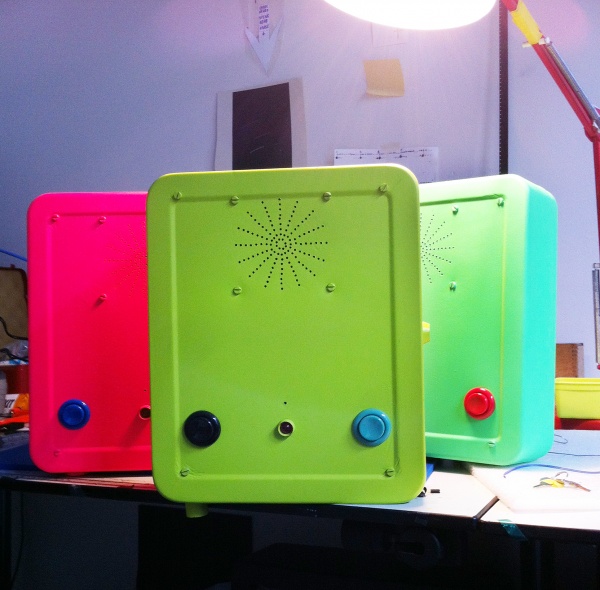
WHY
Because I think it is fascinating how stories and dialogues are formed between strangers in cities through interventions in the public realm. How can different locations become places of entry into a collaborative audio story, a non-instant dialogue, created by acts of strangers. The boxes provide playful performative moments for passers by to break from routine and enter into a network of anonymous voices, travelling an unplanned journey trough cityscapes. An attempt create a drifting sonic dialogue between people in cities. Public space is important, because it is detached from the regulation of online user accounts, profiles and any instant identity. It is a social environment is created by collective anonymity. The voice is an anonymous aural fingerprint that connects strangers together for a brief moment in time. I think of the voice chain in public space like throwing a message in a bottle, not an ocean but in a river. The message goes along the flow and reaches a next person that opens it up out of curiosity and has the chance to put his own instead and let the bottle continue the journey.
HOW
The leaveamessage box is a DIY device working with the open source development platform raspbery pi (single-board computer) . It needs only electricity and internet connection (wifi or cable). It can be hosted by anyone, anywhere in the world. Actually it is looking for hosts, people that want to engage a space into this non-instant, anonymous dialogue, distributed trough streets, cities, countries. The leaveamessage box can be easily made by anyone that has basic knowledge in electronics.
PROCESS and RESEARCH
text text text here here here
CH2
when a voice does not come from your pocket
In the following chapter I will make a brief historical overview of the disconnected voice, before and after the telephone. This chapter will follow how the disembodied voice shifted its meaning and position, from mystical to ubiquitous. I will argue that recently it has started to return to its mystical qualities due to voice calls are not as common as before. This will contextualize and elaborate why it is important for my project to employ the disembodied voice. I will also outline the connection between voice and space. Why is it important to place the disconnected voice static in public space. How does the voice change its character once it remains ( is recorded)? It becomes a document of that place in time. It becomes an object. When voice comes from a specific, fixed place it is the object of a location. One has to be there, and does not carry the opportunity to talk in his own pocket. It is no longer attached to your personal object. The voices and languages inhabiting certain physical areas, create the sonic atmosphere of a place. The boxes provide playful performative moments for passers by to break from routine and enter into a network of anonymous voices, travelling an unplanned journey trough cityscapes. / mention (sound) derive and situationist international.
The displaced voice has always been an ambiguous object. A source of awe but also excitement. Dating back to ancient Greece, where Pythagoras's students could not see him but only hear his voice. The etymology of the word acousmatic comes from the greek word akousma: what is heard. Pythagoras students were called akousmatikoi (hearers).
From imitating to synthesising the voice
Ventriloquism --> from religion, to witchcraft, to performance and entertainment
Ventriloquism could be traces very early in history but I shall touch upon it as such that appeared in the eighteenth century. This was the period when the practice developed as a performance, a spectacle that was established as such by the late 18th century.
Speaking machines synthesising human voice speech...or is it more correct to say voice
Wolfgang Kempelen's speaking machine.
The sounds of the machine have very little linguistic qualities, but imitate non-linguistic human voice sounds.
Project related---> Faced with a recording device, sometimes people tend to make sounds that are very much like the one of the speaking machine of Kempelen.
In any of the cases above, the voice is not dispatched completely. The direction is clear. There is a source, whether the ventriloquist dummy or a speaking machine and the voice comes out of there, as if attached on a string. An invisible but relevant string. This metaphor is made real with the appearance of the telephone. The telephone wire is the string. A voice successfully compressed into a wire, a line. Voice that is extended to travel distances. Alexander Graham Bell is credited with inventing the first practical telephone. He was awarded the first US patent for the telephone in 1876. From that moment on, the voice slowly lost its mystical acousmatic qualities. The excitement of the disattached voice slowly faded and it become a trivial event. In the late nineties, mobile telephony became present. Mobile phones liberated the users from the physical environment. The disembodied voice could appear anywhere.It started to be carried in the pocket. Voice infiltrated the environment as people conversed with each other in public space. This dialogue of mobile telephony in public space still remains somewhat disconnected as it is half coherent, with the other half hidden from the passer-by. A public half-dialogue, part of a private conversation. A monologue extracted from a dialogue. Not being able to grasp the whole, leaves a lot of room for guessing and imagination. *Such fragmented representation of a dialogue, distributed in space relates to my project. In most recent times, mobile phones are smart. No longer they serve to only transmit the voice trough space. Smart phones are our omnipresent communication tool. In our bag, pocket, hand. Mostly in our hand rather next to our ear. Voice calls are being pushed away by other means of communicating, easier ones, visible rather than audible, giving us a chance to be continuously connected, without disturbing the environment. Voice calls are becoming a sort of an event. A voice call signifies some sort of urgency. It is no longer a casual event. Does this mean that the disembodied voice is slowly winning back its mystique power, its ambiguity?
- Somebody who detains you with his speech was once said to be 'buttonholing', you, recalling the practice of physically crooking a finger in the buttonhole of one's interlocutor. Steven Connor / non literal --> relate to the button of the box
- The distant voice is also often enclosed, in boxes, suitcases, cupboards, or even underground. When it is thus enclosed, the voice is imagined as coiled upon itself with the kinetic tension of compression. Steven Connor
Voice is one of the principal ‘extensions’ of man MacLuhan, Marshall (1964). Understanding Media: The Extensions of Man. London: Routledge and Kegan Paul.
- The voice as an object that remains. The recorded voice
- Steven Connor about the voice - voice, as an object of hearing, lacks ‘permanence and continuity’,it ‘belongs to time’. How does this relate and change when it is recorded?
- Sound as a mediator to the environment. Voice as sound in the environment
Sound is intrinsically and unignorably relational: it emanates, propagates, communicates, vibrates, and agitates; it leaves a body and enters others; it binds and unhinges, harmonizes and traumatizes; it sends the body moving, the mind dreaming, the air oscillating. It seemingly eludes definition, while having profound effect. (LaBelle, 2007)
With the telephonic principle, comes another desire, the desire to preserve, to trap sound, not only to convey it trough space. Capturing voice, preserving it and keeping it is part of my project. The recording boxes enclose voice and distribute it to the locations of the other boxes until a new recording is made and takes this place. I believe there is a charged relationship of voice to space and questions of public and private. With the decreasing use of voice calls, voice in public space remains embodied. Perhaps amongst the few examples of disembodied voices in public space are the announcements in public transport. With a small device distributed to various public spaces I try to investigate the situation in which anyone's voice could remain aloud in space without its beholder. Each voice becomes a temporary site-specific sound installation.

